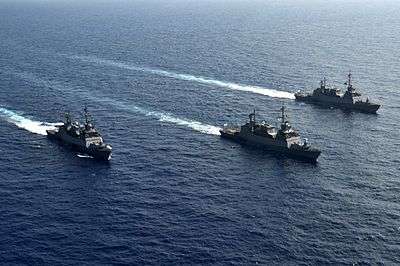Sa'ar 5-class corvette
 Three Sa'ar 5-class corvettes cruise off the shore of Israel during a training exercise | |
| Class overview | |
|---|---|
| Name: | Sa'ar 5 class |
| Builders: | Northrop Grumman by Ingalls Shipbuilding |
| Operators: |
|
| Preceded by: | Sa'ar 4.5 class |
| Succeeded by: | Sa'ar 6 class |
| Completed: | 3 |
| Active: | INS Eilat, INS Lahav, INS Hanit |
| General characteristics | |
| Type: | Corvette |
| Displacement: | |
| Length: | 85.64 m (280.97 ft) |
| Beam: | 11.88 m (38.98 ft) |
| Draft: | 3.45 m (11.32 ft) |
| Propulsion: | |
| Speed: |
|
| Range: | 3,500 nautical miles (6,500 km) |
| Complement: |
|
Sa'ar 5 (Hebrew: סער 5) is a class of Israeli Navy corvettes, designed based on lessons learned from the Sa'ar 4.5-class missile boats. Three Sa'ar 5 ships were built by Huntington Ingalls Industries (formerly Litton-Ingalls Shipbuilding Corporation of Pascagoula, Mississippi) for the Israeli Navy, based on Israeli designs.
They are the largest surface warships in Israel's naval fleet. Although classified as "corvettes" due to their small size and crew of only 71, their weaponry and speed are almost comparable to that of a frigate. They are equipped with sonar, torpedoes, missile launchers, electronic warfare capabilities and decoys, a gun mount, and a helipad and helicopter hangar.[1]
The first of class, INS Eilat, was launched in February 1993, followed by INS Lahav in August 1993 and INS Hanit in March 1994.
Combat history
During the 2006 Lebanon War, INS Hanit was attacked by a Hezbollah missile as it was enforcing a naval blockade off Beirut. The resulting explosion caused the landing pad to cave in and be engulfed in flames that threatened the aviation fuel storage below, and the flames were not fully extinguished until several hours later. Four sailors were killed and the ship suffered some damage, but she stayed afloat, got out of the line of fire, and returned unassisted to Ashdod for repairs. The ship was repaired and resumed its combat role three weeks later.[2]
.jpg)
An investigation into the attack by the Israeli Navy concluded that the missile was an Iranian version of the Chinese C-802, which hit a crane in the rear of the ship. The ship's radar system was not fully functional at the time, and both the ECM and the Barak anti-missile systems were in a two-minute stand-by mode. An officer ordered that the anti-missile defenses be switched off about an hour prior to the attack without notifying the captain. The decision took into account intelligence assessments that Hezbollah did not have the capability to hit Israeli warships. The partial sensor shutdowns were known by the officer responsible, but the captain was not informed.[3][4]
In August 2009 INS Eilat and INS Hanit passed through the Suez Canal into the Red Sea, along with a Dolphin-class submarine. The move was seen as a possible warning to Iran.[5]
On 31 May 2010 INS Lahav and INS Hanit participated in the Gaza flotilla raid, meant to stop a convoy of ships from breaching the blockade of the Gaza Strip, along with the missile boat INS Nitzachon.
Ships
Three ships of the Sa'ar 5 class have been built:
The ship's missiles systems is a set of: (i) anti-air capability with 32-cell vertical launch systems, with Barak-1 missiles of IAI and Rafael, and (ii) two four-cell Boeing Harpoon missile launchers.
Ship's guns are a Raytheon / General Dynamics MK15 Phalanx 20 mm close-in weapon system (CIWS). An Oto Melara 76mm gun was project but until now not provided.
See also
References
- ↑ "21st Century Frigates Today". G2mil.com. Retrieved 17 July 2015.
- ↑ "Strike on Israeli Navy Ship". NAVSEA. 2006-07-19. Archived from the original on 22 July 2009.
- ↑ Greenberg, Hanan (11 July 2006). "Report: Ship crew didn't realize missile threat". Ynetnews. Retrieved 17 July 2015.
- ↑ Harel, Amos (8 November 2006). "Missile attack on INS Spear: IDF probe faults navy, ship's crew". Haaretz. Retrieved 17 July 2015.
- ↑ Katz, Yaakov (14 July 2009). "2 IDF warships cross Suez to Red Sea". The Jerusalem Post. Retrieved 17 July 2015.
External links
| Wikimedia Commons has media related to Sa'ar 5-class corvettes. |
- Naval Technology
- Global Security
- Hazegray
- Ha'aretz: 4 soldiers missing after naval vessel hit off Beirut coast